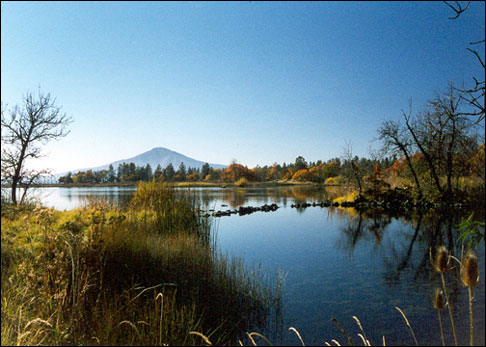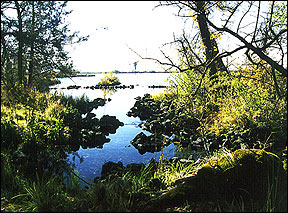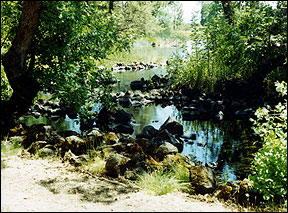
© Althea Wong 2003
Stone fish traps were constructed by the native Pit River groups in northeastern California. These ingeniously simple and efficient fishing structures were used to harvest the Sacramento sucker (Catostomus occidentalis), a bottom dwelling, boney fish that reached a size of 18 inches and weighed five pounds or more. The suckers spawn between late January and early June, with the heaviest activity being in February. During this period, they collect in large schools during the daylight hours and as evening approaches, the suckers move into the shallows where spawning is done in the flows of cold spring water. The Pit River people harvested Sacramento suckers by understanding the spawning behavior of the species and its habitat, while helping to propagate and actively manage this fishery resource with their stone fish traps.

The photos show the lava fish traps that were used by the native Ajumawi people, one of nine bands of the Pit River Indians who occupied a large area of northeastern California. The fish traps are located in the Ahjumawi Lava Springs State Park. A description of the park, by John W. Foster, Senior State Archaeologist of California State Parks, explains the unique landscape that draws the suckers to the area.
The state park is composed of a vast lava field on the north extending many miles beyond the park boundary. This is the result of a geologically recent flow, perhaps 2,000 years in age, resulting in a landscape of sharp-edged rock, craters, pressure ridges and lava tubes. The aqueous setting is as soft as the land is harsh. Where lava meets lake is a zone of critical importance. The lava flow collects rainfall over a vast area. It percolates through the broken rock, collects in great volume and issues through a series of reliable cold-water springs into the lake. These occur mainly along the shore, although several important flows can be detected in the main body of the Big Lake itself.
The traps utilize the flow of the clear, cool waters emerging from the lava and the propensity of suckers to seek these lakeside springs for spawning.



Common elements of the Ajumawi stone fish trap consisted of a large outer wall that formed an impoundment, connecting two points of land.
Water depth may be 50-150 cm and the stone wall is built up to the lake level using three courses of lava stones or more. A central opening measuring 20-50 cm is designed to allow suckers to enter. It can be closed with a keystone (which can sometimes be seen underwater) or a log, dip net or canoe prow. The outer wall and opening serve to concentrate the spring outflow as it enters the lake, making a strong attraction flow to the spawning suckers.
Within the stone enclosure there is sometimes found a series of rock alignments forming an inner chamber. These invariably lead to a strong spring flow. They are constructed from lava rock near the spring itself. This exposes a layer of smaller vesicular gravels over which the spring waters issue. The most complex trap within the park is constructed at Crystal Spring. Here an elaborate maze of interior channels, chambers, rock piles and outer wall direct the spawning fish into very shallow water. During the peak spawning season, the preoccupied fish can be touched from the bank as they deposit eggs on the gravels. (Foster)
Harvesting of the suckers, by the Ajumawi, was done during the evening. The outside enclosure opening was blocked, torches were lit, and the fish were collected using hands, nets, spears, or basket scoops.
When an adequate supply was taken, the trap was reopened and fish were allowed to resume their spawn. Occasionally, it would be left closed until the following day, but great care was taken to allow the spawn to be successful. (Foster)
The fish catch were gutted and sun-dried or smoked over a wooden frame.
For more information about Ajumawi fish traps, access the article by John W. Foster, Senior State Archaeologist of
California State Parks. His article is entitled, "Native Fish Traps Along the Shore of Ahjumawi Lava Springs State Park".
This article was first published in The
Bulletin of Primitive Technology (Spring 2003, #25)
E-mail your comments to "Dino Labiste" at KahikoArts@yahoo.com
We hope the information on the PrimitiveWays website is both instructional and enjoyable. Understand that no warranty or guarantee is included. We expect adults to act responsibly and children to be supervised by a responsible adult. If you use the information on this site to create your own projects or if you try techniques described on PrimitiveWays, behave in accordance with applicable laws, and think about the sustainability of natural resources. Using tools or techniques described on PrimitiveWays can be dangerous with exposure to heavy, sharp or pointed objects, fire, stone tools and hazards present in outdoor settings. Without proper care and caution, or if done incorrectly, there is a risk of property damage, personal injury or even death. So, be advised: Anyone using any information provided on the PrimitiveWays website assumes responsibility for using proper care and caution to protect property, the life, health and safety of himself or herself and all others. He or she expressly assumes all risk of harm or damage to all persons or property proximately caused by the use of this information.
© PrimitiveWays 2017